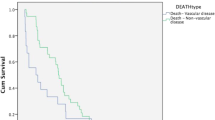Abstract
Purpose
Carotid endarterectomy and stenting are used to treat carotid stenosis, with the volume of carotid artery procedures increasing over the past decade. We investigated the 10-year trend of periprocedural complications with an increasing procedure volume of carotid stenting at a single tertiary hospital.
Methods
We collected 416 consecutive cases (384 patients) of carotid artery stenting performed for either symptomatic (231 cases, 55.5 %) or asymptomatic (185 cases, 44.5 %) internal carotid artery stenosis at a single center. Periprocedural complication was defined as any stroke, myocardial infarction, or death. Procedure-related outcome included any dissection, hemodynamic event, or periprocedural complication.
Results
The mean age was 68.8 years (82.8 % males; range of 20–89 years); 23.9 % were older than 75 years. Before the procedure, 99.3 and 56.0 % of patients received antiplatelet and lipid-lowering medication, respectively. The overall periprocedural complication rate was 3.6 % (1.6 and 5.2 % in the asymptomatic and symptomatic group, respectively). The composite outcome of any stroke or death was 3.4 %. Periprocedural complication and procedure-related outcome showed a decremental trend with increasing procedure volume, and this trend remained after adjusting for confounders.
Conclusions
Our study suggests that carotid stenting at an experienced center might reduce the periprocedural complications. Our periprocedural complication rate of carotid artery stenting may be comparable to, or somewhat lower than, that reported in other clinical trials.

Similar content being viewed by others
References
Yadav JS, Wholey MH, Kuntz RE et al (2004) Protected carotid-artery stenting versus endarterectomy in high-risk patients. N Engl J Med 351(15):1493–1501
Mas JL, Chatellier G, Beyssen B et al (2006) Endarterectomy versus stenting in patients with symptomatic severe carotid stenosis. N Engl J Med 355(16):1660–1671
Brott TG, Hobson RW 2nd, Howard G et al (2010) Stenting versus endarterectomy for treatment of carotid-artery stenosis. N Engl J Med 363(1):11–23
Silver FL, Mackey A, Clark WM et al (2011) Safety of stenting and endarterectomy by symptomatic status in the Carotid Revascularization Endarterectomy Versus Stenting Trial (CREST). Stroke 42(3):675–680
Zahn R, Roth E, Ischinger T et al (2005) Carotid artery stenting in clinical practice results from the Carotid Artery Stenting (CAS)-registry of the Arbeitsgemeinschaft Leitende Kardiologische Krankenhausarzte (ALKK). Z Kardiol 94(3):163–172
Brott TG, Halperin JL, Abbara S et al (2011) 2011 ASA/ACCF/AHA/AANN/AANS/ACR/ASNR/CNS/SAIP/SCAI/SIR/SNIS/SVM/SVS guideline on the management of patients with extracranial carotid and vertebral artery disease. Stroke 42(8):e464–540
Bates ER, Babb JD, Casey DE Jr et al (2007) ACCF/SCAI/SVMB/SIR/ASITN 2007 clinical expert consensus document on carotid stenting: a report of the American College of Cardiology Foundation Task Force on Clinical Expert Consensus Documents (ACCF/SCAI/SVMB/SIR/ASITN Clinical Expert Consensus Document Committee on Carotid Stenting). J Am Coll Cardiol 49(1):126–170
Nallamothu BK, Gurm HS, Ting HH et al (2011) Operator experience and carotid stenting outcomes in Medicare beneficiaries. JAMA 306(12):1338–1343
Lin PH, Bush RL, Peden EK et al (2005) Carotid artery stenting with neuroprotection: assessing the learning curve and treatment outcome. Am J Surg 190(6):850–857
Verzini F, Cao P, De Rango P et al (2006) Appropriateness of learning curve for carotid artery stenting: an analysis of periprocedural complications. J Vasc Surg 44(6):1205–1211
North American Symptomatic Carotid Endarterectomy Trial (1991) Methods, patient characteristics, and progress. Stroke 22(6):711–720
Thygesen K, Alpert JS, Jaffe AS et al (2012) Third universal definition of myocardial infarction. Circulation 126(16):2020–2035
Brown MM, Rogers J, Bland JM et al (2001) Endovascular versus surgical treatment in patients with carotid stenosis in the Carotid and Vertebral Artery Transluminal Angioplasty Study (CAVATAS): a randomised trial. Lancet 357(9270):1729–1737
Ederle J, Dobson J, Featherstone RL et al (2010) Carotid artery stenting compared with endarterectomy in patients with symptomatic carotid stenosis (International Carotid Stenting Study): an interim analysis of a randomised controlled trial. Lancet 375(9719):985–997
Executive Committee for the Asymptomatic Carotid Atherosclerosis Study (1995) Endarterectomy for asymptomatic carotid artery stenosis. JAMA 273(18):1421–1428
Halliday A, Mansfield A, Marro J et al (2004) Prevention of disabling and fatal strokes by successful carotid endarterectomy in patients without recent neurological symptoms: randomised controlled trial. Lancet 363(9420):1491–1502
Fairman R, Gray WA, Scicli AP et al (2007) The CAPTURE registry: analysis of strokes resulting from carotid artery stenting in the post approval setting: timing, location, severity, and type. Ann Surg 246(4):551–556 discussion 556-558
Gray WA, Hopkins LN, Yadav S et al (2006) Protected carotid stenting in high-surgical-risk patients: the ARCHeR results. J Vasc Surg 44(2):258–268
Mendelsohn FO, Weissman NJ, Lederman RJ et al (1998) Acute hemodynamic changes during carotid artery stenting. Am J Cardiol 82(9):1077–1081
Karkos CD, Karamanos DG, Papazoglou KO, Demiropoulos FP, Papadimitriou DN, Gerassimidis TS (2010) Thirty-day outcome following carotid artery stenting: a 10-year experience from a single center. Cardiovasc Interv Radiol 33(1):34–40
Miyachi S, Taki W, Sakai N, Nakahara I, The Japanese CAS, Survey Investigators (2012) Historical perspective of carotid artery stenting in Japan: analysis of 8,092 cases in The Japanese CAS survey. Acta Neurochir 154(12):2127–2137
Acknowledgment
This study was supported by a Grant from Seoul National University Bundang Hospital (02-2005-011).
Conflict of interest
All authors have no confliction interests to disclose.
Author information
Authors and Affiliations
Corresponding author
Rights and permissions
About this article
Cite this article
Hong, JH., Kang, J., Yeo, MJ. et al. The 10-year Trend of Periprocedural Complication Following Carotid Artery Stenting; Single Center Experience. Cardiovasc Intervent Radiol 38, 280–287 (2015). https://doi.org/10.1007/s00270-014-0917-y
Received:
Accepted:
Published:
Issue Date:
DOI: https://doi.org/10.1007/s00270-014-0917-y




